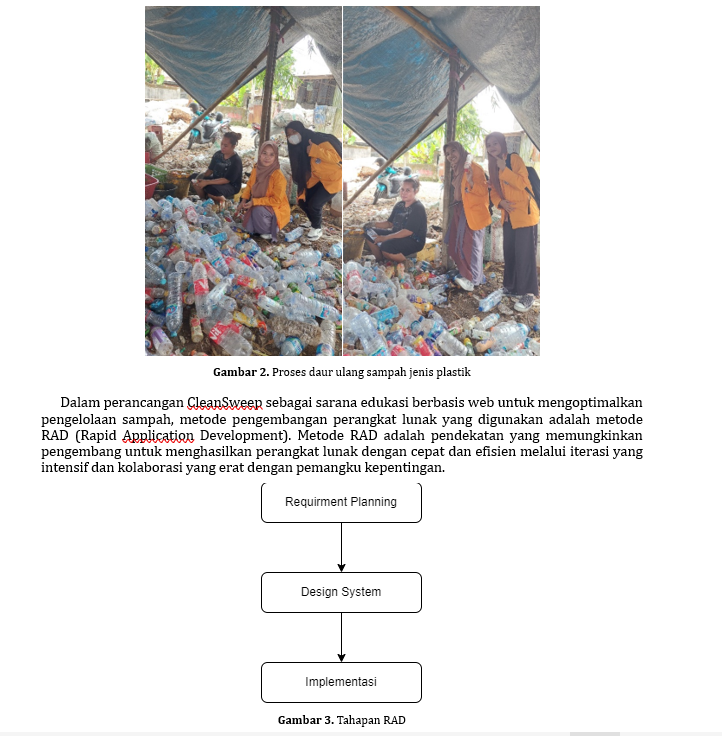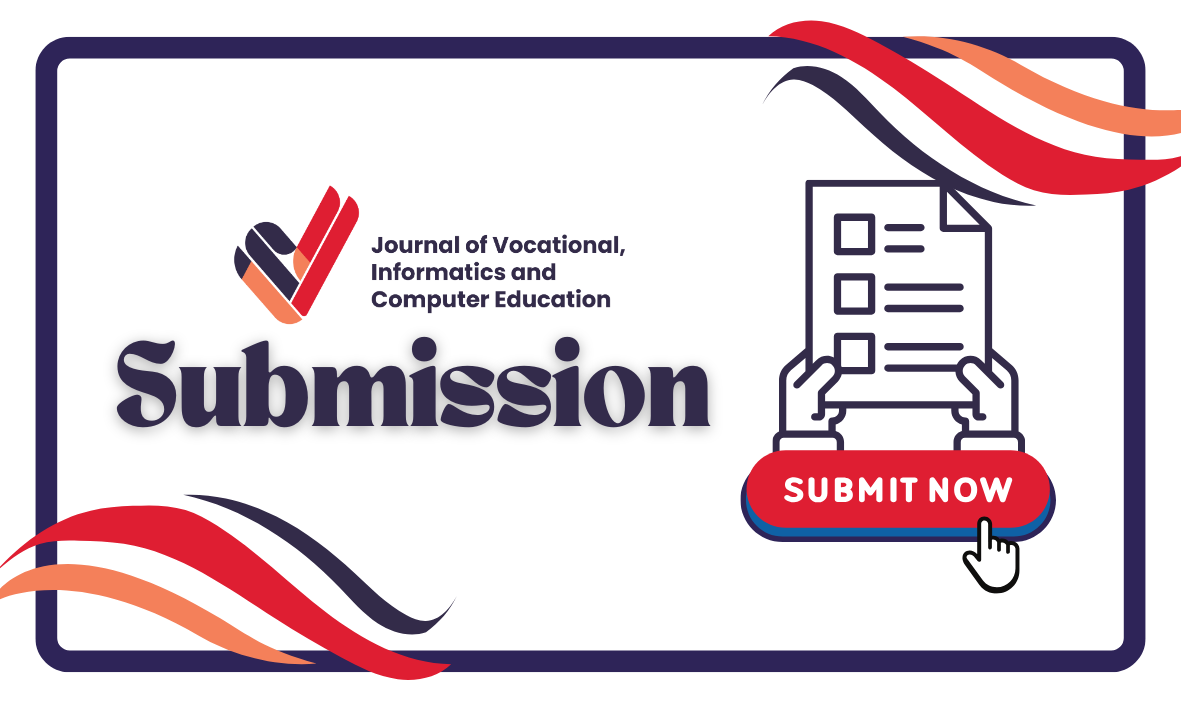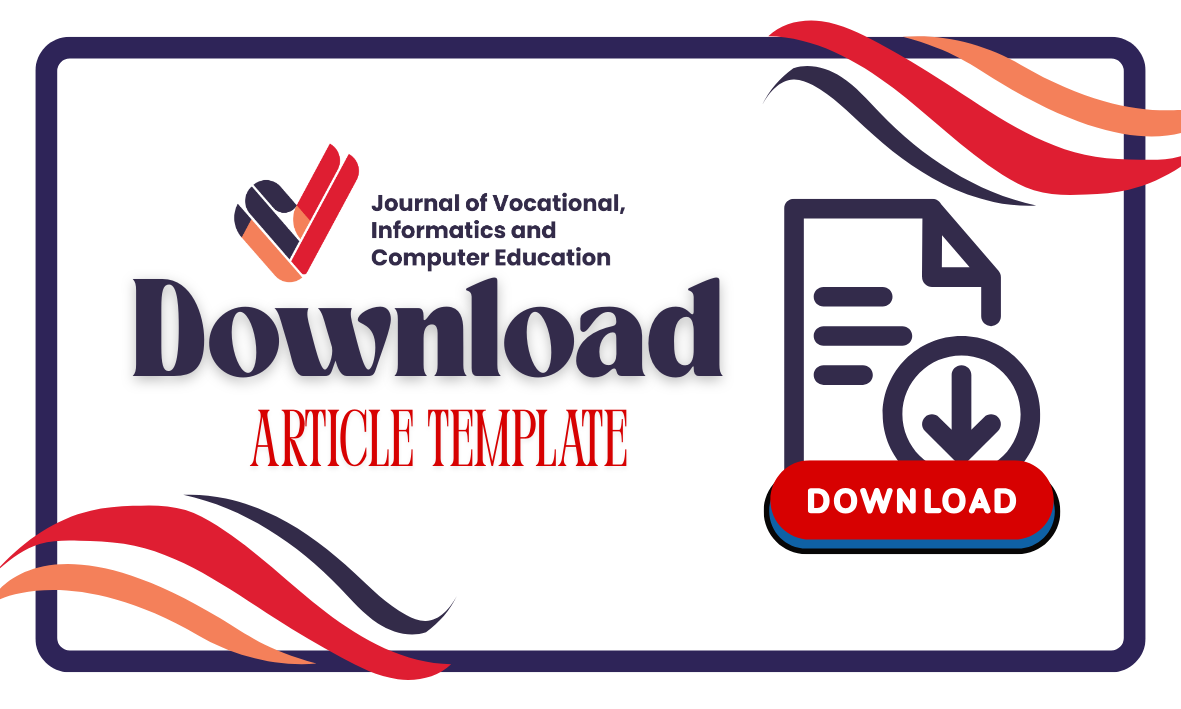Perancangan CleanSweep sebagai Sarana Edukasi Berbasis Web dalam Mengoptimalkan Pengelolaan Sampah
DOI:
https://doi.org/10.61220/voice.v1i1.20234Keywords:
CleanSweep, Edukasi, Interaktif, Pengelolaan Sampah, WebAbstract
Perkembangan teknologi informasi yang pesat, serta kesadaran akan pentingnya pengelolaan sampah yang efektif di lingkungan masyarakat, mendorong pencarian solusi inovatif untuk mengatasi masalah lingkungan. Sampah yang tidak dikelola dengan baik dapat menyebabkan pencemaran dan berdampak pada kesehatan masyarakat. Oleh karena itu, dibutuhkan platform edukasi yang dapat memberikan pemahaman kepada masyarakat mengenai pengelolaan sampah yang baik. Penelitian ini bertujuan untuk merancang CleanSweep, sebuah sistem edukasi berbasis web yang dirancang untuk mengoptimalkan pengelolaan sampah. Platform ini bertujuan untuk memberikan informasi yang komprehensif dan langkah-langkah praktis terkait pengelolaan sampah yang baik, serta mendorong partisipasi aktif masyarakat. Metode penelitian yang digunakan dalam pengembangan CleanSweep adalah studi literatur, wawancara dengan para ahli dan praktisi, serta observasi terhadap praktik pengelolaan sampah yang ada di masyarakat. Selain itu, metode pengembangan perangkat lunak yang digunakan adalah RAD (Rapid Application Development), yang memungkinkan pembuatan aplikasi dengan cepat melalui iterasi yang intensif. Hasil penelitian ini berupa pengembangan aplikasi web CleanSweep yang menyediakan berbagai konten edukatif mengenai jenis sampah, pemilahan sampah, daur ulang, dan manajemen limbah. Aplikasi ini dirancang dengan tampilan antarmuka yang user-friendly dan interaktif, memungkinkan pengguna untuk mengakses informasi dengan mudah. CleanSweep dapat memberikan solusi efektif untuk meningkatkan kesadaran masyarakat mengenai pengelolaan sampah yang baik. Namun, keterbatasan dari penelitian ini adalah masih kurangnya fitur yang dapat meningkatkan interaksi pengguna, seperti pelaporan sampah atau forum diskusi. Penelitian lebih lanjut disarankan untuk mengembangkan fitur-fitur tambahan yang dapat memperkuat keterlibatan masyarakat dalam pengelolaan sampah.
Downloads
References
[1] L. Andeobu, S. Wibowo, and S. Grandhi, “A Systematic Review of E-Waste Generation and Environmental Management of Asia Pacific Countries,” Int. J. Environ. Res. Public. Health, vol. 18, no. 17, p. 9051, Aug. 2021, doi: 10.3390/ijerph18179051.
[2] P. Lestari and Y. Trihadiningrum, “The impact of improper solid waste management to plastic pollution in Indonesian coast and marine environment,” Mar. Pollut. Bull., vol. 149, p. 110505, Dec. 2019, doi: 10.1016/j.marpolbul.2019.110505.
[3] “Political Economy of Import Waste Regulations in East Java: Implications of Indonesia’s Role as Waste Importer Country,” in Nusantara Science and Technology Proceedings, Galaxy Science, Apr. 2021. doi: 10.11594/nstp.2021.0930.
[4] M. Z. Elamin et al., “Analysis of Waste Management in The Village of Disanah, District of Sreseh Sampang, Madura,” J. Kesehat. Lingkung., vol. 10, no. 4, p. 368, Dec. 2018, doi: 10.20473/jkl.v10i4.2018.368-375.
[5] D. Susilo, M. V. De Leon, T. Dwi Putranto, and F. Kurnia Hartati, “Food waste handling perception in Indonesia: communicating the sustainability of Food and environment,” IOP Conf. Ser. Earth Environ. Sci., vol. 892, no. 1, p. 012109, Nov. 2021, doi: 10.1088/1755-1315/892/1/012109.
[6] L. Muliawaty, “IMPLEMENTATION OF MUNICIPAL SOLID WASTE MANAGEMENT IN INDONESIA,” Humanit. Soc. Sci. Rev., vol. 8, no. 2, pp. 854–861, Aug. 2020, doi: 10.18510/hssr.2020.8294.
[7] W. Wahyudin, S. Syamsiah, and S. Sunjoto, “SISTEM PENGELOLAAN SAMPAH PERKOTAAN DI KOTA BIMA PROVINSI NUSA TENGGARA BARAT (System of Municipal Solid Waste Management in Bima City West Nusa Tenggara Province),” J. Mns. Dan Lingkung., vol. 24, no. 3, p. 103, Sep. 2017, doi: 10.22146/jml.30101.
[8] A. Latifah, A. Mulyani, and T. Agusviani Wahidah, “Rancang Bangun Sistem Pengelolaan Kebersihan di Lingkungan Institut Teknologi Garut Berbasis Website,” J. Algoritma, vol. 19, no. 2, pp. 747–758, Nov. 2022, doi: 10.33364/algoritma/v.19-2.1216.
[9] F. Gu, W. Zhang, J.-F. Guo, and P. Hall, “Exploring ‘Internet+Recycling’: Mass balance and life cycle assessment of a waste management system associated with a mobile application,” Sci. Total Environ., vol. 649, Aug. 2018, doi: 10.1016/j.scitotenv.2018.08.298.
[10] J. Li, S. Krishnamurthy, A. Pereira Roders, and P. van Wesemael, “Community participation in cultural heritage management: A systematic literature review comparing Chinese and international practices,” Cities, vol. 96, p. 102476, Jan. 2020, doi: 10.1016/j.cities.2019.102476.
[11] M. Eva, “Requirements acquisition for rapid applications development,” Inf. Manage., vol. 39, no. 2, pp. 101–107, Dec. 2001, doi: 10.1016/S0378-7206(01)00082-9.
[12] S. K. Markham, “The Impact of Front-End Innovation Activities on Product Performance,” J. Prod. Innov. Manag., vol. 30, no. S1, pp. 77–92, Dec. 2013, doi: 10.1111/jpim.12065.37
[13] M. Tanveer, S. A. R. Khan, M. Umar, Z. Yu, M. J. Sajid, and I. U. Haq, “Waste management and green technology: future trends in circular economy leading towards environmental sustainability,” Environ. Sci. Pollut. Res., vol. 29, no. 53, pp. 80161–80178, Nov. 2022, doi: 10.1007/s11356-022-23238-8.
[14] S. Nanda and F. Berruti, “Municipal solid waste management and landfilling technologies: a review,” Environ. Chem. Lett., vol. 19, no. 2, pp. 1433–1456, Apr. 2021, doi: 10.1007/s10311-020-01100-y.
[15] K. Pardini, J. J. P. C. Rodrigues, O. Diallo, A. K. Das, V. H. C. De Albuquerque, and S. A. Kozlov, “A Smart Waste Management Solution Geared towards Citizens,” Sensors, vol. 20, no. 8, p. 2380, Apr. 2020, doi: 10.3390/s20082380.
[16] M. Paul and M. J. Bussemaker, “A web-based geographic interface system to support decision making for municipal solid waste management in England,” J. Clean. Prod., vol. 263, p. 121461, Aug. 2020, doi: 10.1016/j.jclepro.2020.121461.
[17] Y. A. Fatimah, K. Govindan, R. Murniningsih, and A. Setiawan, “Industry 4.0 based sustainable circular economy approach for smart waste management system to achieve sustainable development goals: A case study of Indonesia,” J. Clean. Prod., vol. 269, p. 122263, Oct. 2020, doi: 10.1016/j.jclepro.2020.122263.
[18] D. S. Wisnubroto, H. Zamroni, R. Sumarbagiono, and G. Nurliati, “Challenges of implementing the policy and strategy for management of radioactive waste and nuclear spent fuel in Indonesia,” Nucl. Eng. Technol., vol. 53, no. 2, pp. 549–561, Feb. 2021, doi: 10.1016/j.net.2020.07.005.
[19] K. V. Vlasenko et al., “UI/UX design of educational on-line courses,” CTE Workshop Proc., vol. 9, pp. 184–199, Mar. 2022, doi: 10.55056/cte.114.
[20] W. Farhan, J. Razmak, S. Demers, and S. Laflamme, “E-learning systems versus instructional communication tools: Developing and testing a new e-learning user interface from the perspectives of teachers and students,” Technol. Soc., vol. 59, p. 101192, Nov. 2019, doi: 10.1016/j.techsoc.2019.101192.
[21] Y. Zhang et al., “How important is community participation to eco-environmental conservation in protected areas? From the perspective of predicting locals’ pro-environmental behaviours,” Sci. Total Environ., vol. 739, p. 139889, Oct. 2020, doi: 10.1016/j.scitotenv.2020.139889.

Downloads
Published
Issue
Section
License
Copyright (c) 2023 Wahyu Hidayat M, Zainab, Hastuti, Nurul Syahputri, Ahmad Miftahurrahman Anwar, Muh. Juharman (Author)

This work is licensed under a Creative Commons Attribution-ShareAlike 4.0 International License.




















 Email : voice@lontaradigitech.com
Email : voice@lontaradigitech.com
